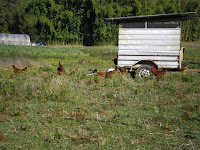Lots of work. This is gardening traditional style, at least at first glance. I had hoped (OK, the lazy part in me had hoped) that permaculture would eliminate the need for soil tillage, planting annuals, weeding, nursery, fertilizing… Well it is not so. At least not in the beginning if you want to be growing your own plants quickly. We spent time this week learning to make soil mix for seedlings, picking seeds, planting seedlings into pots, preparing a nursery, building a fabric greenhouse, planting seeds, and tending the main garden and new kitchen garden. If you wish to get your food production going quick, this is the way to start. But even here, when setting up a primarily annual garden, the whispers of permaculture are at work. Consider the design. Where is the sun? What are you going to need to water? How do you get the water there? What does the soil need to be healthy for the plants or for the people or animals eating the plants? What is the slope? These questions are ones leading permaculture design. They are not new questions, just questions that need to be asked to grow healthy plants. But we can go on. How can I design this garden so it is easy to harvest? How can I set up this garden so it minimizes opportunities for undesirable plants (weeds)? Where can I put the garden so I can easily get to it? Often we forget, in our enthusiasm and spring energy, to think about some of these questions. By spending a little bit more time in planning, we can cut off hours to weeks of needless working time, when we could be spending the time harvesting, storing, or preparing the food.
As we develop our understanding of permaculture, and we can develop our own land or work with cooperative neighbors, we can move towards further reducing our labor by growing more perennial or self seeding annuals or bi-annuals. Work animals into the system and we can put them to work weeding, eating insects, tilling the soil, guarding from predators or uninvited guests.
This experience is teaching me that we need to offer more gardening related teaching opportunities in our community. To develop and share in block or community gardens, not just our produce, but our enthusiasm, experience, positive support and assistance to those new to gardening.











